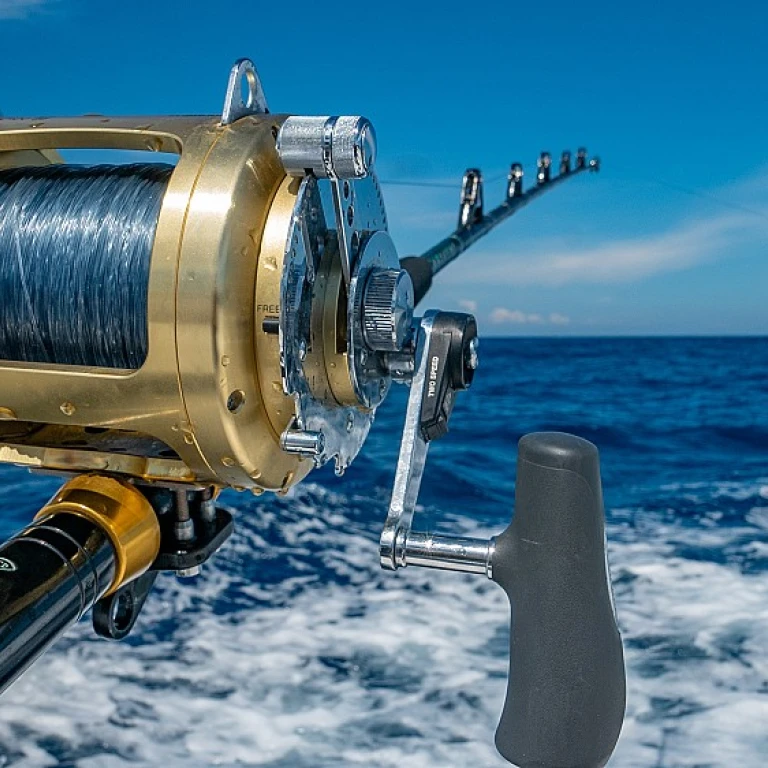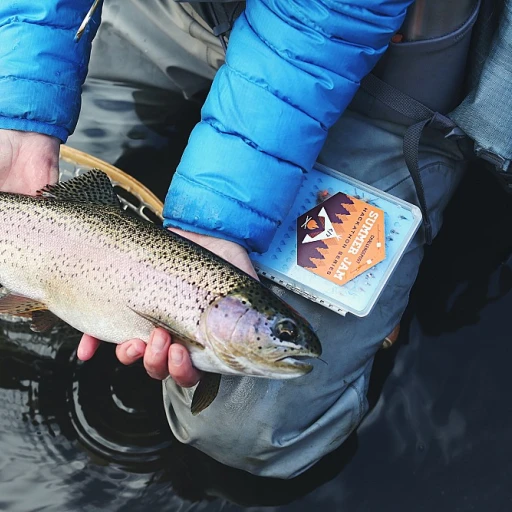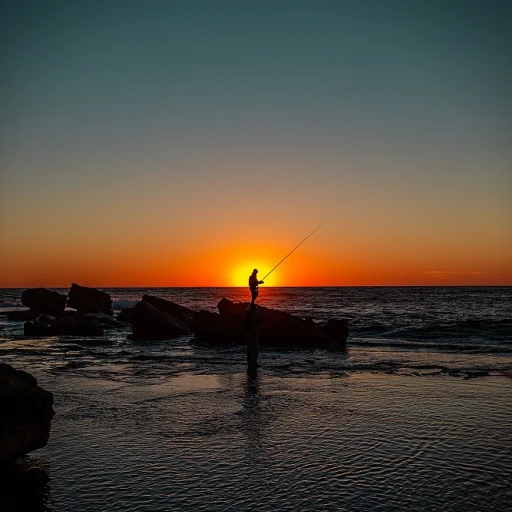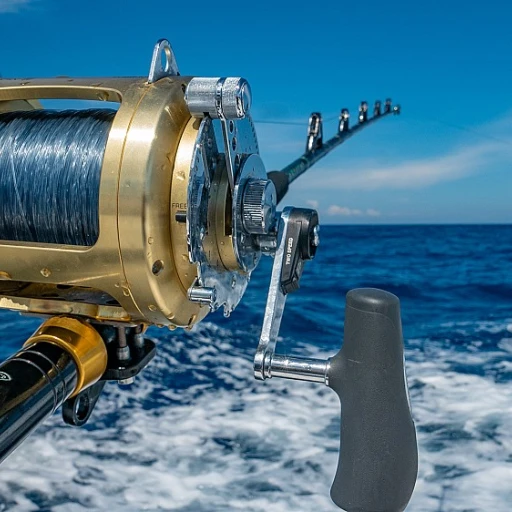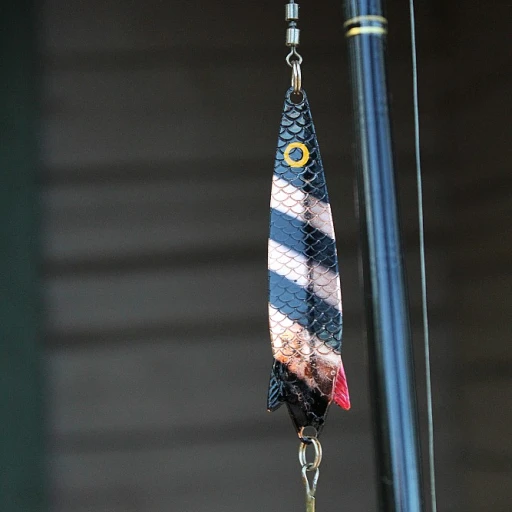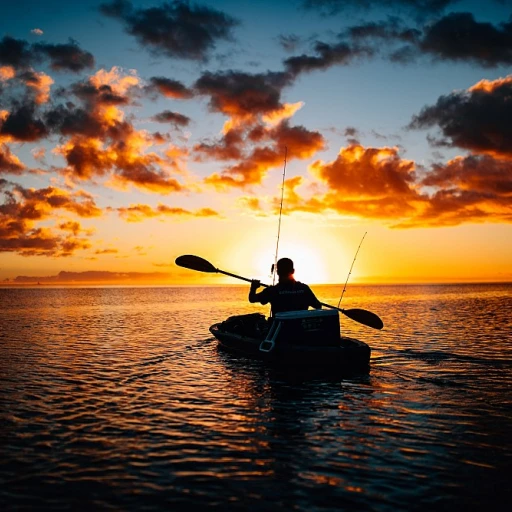The legend of the record muskie
Unveiling the legendary record muskie
Every angler dreams of being the one to reel in a muskie that defies belief. These colossal fish, often referred to as muskellunge or musky, are among the most coveted game fish in North America. But what makes a record muskie so legendary?
Throughout history, locales like Hayward, Wisconsin, and the famous St. Lawrence River have been synonymous with the fish caught that gentlemen of myths and legends talked about, bringing in muskies that tip the scales. Back in 1949, Cal Johnson set the world record muskie catch. He pulled in a behemoth weighing 67 pounds, 8 ounces in the Chippewa Flowage near Hayward, Wisconsin. This record stood strong, symbolizing the pinnacle of freshwater fishing glory.
The name Louis Spray also rings a bell with record muskie enthusiasts. Spray's 1939 monster muskie weighed 69 pounds, 11 ounces, caught in the waters of Lake Court Oreilles in Wisconsin. This ’ol tale stirred a lot of buzz and skepticism, triggering debates that would see its way to the modern era.
In recent times, the International Game Fish Association (IGFA) has been at the forefront of these discussions, ensuring standards for record fish authenticity and merit. That's why every muskie caught, weighing pounds and ounces, is scrutinized to the last detail before it enters the hall of fame.
Anglers like Larry Ramsell and Derek Balmas from Franklinville have dedicated their lives to chasing these freshwater giants, each big fish they catch etched deeply in the annals of muskie lore. With their meticulous records and vivid storytelling, this pursuit isn’t just about fishing; it's about legacy.
Famous record muskie catches
Cal johnson's legendary muskie catch
In the realm of fishing, few moments stand out as profoundly as Cal Johnson's historic catch. On July 24, 1949, Johnson reeled in a muskie weighing 67 pounds 8 ounces and measuring 60.25 inches long from Lake Court Oreilles in Hayward, Wisconsin. This monumental catch has since become the stuff of fishing legend.
The myth of louis spray's giant muskie
Another record-setting muskie comes from the tales of Louis Spray, who supposedly caught a monster weighing 69 pounds 11 ounces back in 1949. This fish was caught in the Chippewa Flowage and is still revered by many anglers. However, Spray's record has faced significant scrutiny, leading to doubts about its authenticity.
Arthur lawton and the mythical st. lawrence river muskie
Arthur Lawton is known for his claim of catching a mammoth muskie weighing 69 pounds 15 ounces from the St. Lawrence River in 1957. While the record stood for a long time, it was ultimately disqualified by the IGFA due to inconsistencies and a lack of verifiable evidence.
Derek balmas and his magnificent catch
Fast forward to the modern era, Derek Balmas from Franklinville, New York, grabbed headlines with his sizeable catch. In 2018, Balmas hooked a muskie weighing 65 pounds from Blackstone Harbour, a part of Georgian Bay in Ontario. This catch reignited interest and debates around record-setting muskies.
Interested in giant catches beyond muskies? Check out our look into the biggest striped bass ever caught for more thrilling fishing adventures.
The science behind catching a record muskie
Understanding the biology and behavior of muskies
Catching a record muskie is no small feat, and understanding the fish's biology and behavior is key. Muskies (Esox masquinongy) are the largest members of the pike family and are known for their elusive nature. Nicknamed the 'fish of 10,000 casts,' they are notoriously difficult to catch.
Research has shown that muskies prefer cool, clear waters and are often found in large lakes and river systems. They are apex predators in the freshwater ecosystems they inhabit, primarily feeding on other fish such as suckers, perch, and minnows. This predatory behavior makes them particularly attracted to large, flashy lures, which anglers often use to mimic their natural prey.
Prime times and locations for catching muskies
Timing and location play a significant role in increasing the chances of catching a record muskie. Studies indicate that muskies are most active during dawn and dusk, especially in the warmer months of the year when water temperatures are between 60 to 70 degrees Fahrenheit. One famous location for muskie fishing is the St. Lawrence River, which has produced several record catches, including Louis Spray's legendary muskie caught in 1949, weighing 69 pounds, 11 ounces.
Additionally, bodies of water such as Wisconsin's Chippewa Flowage and Ontario's Georgian Bay are renowned for their muskie populations. These locations have produced numerous state and world record catches, drawing in anglers from all over the world.
The tactics and gear needed for a record catch
Anglers aiming to catch a record-setting muskie often rely on specialized equipment and tactics. Heavy-duty rods, strong lines, and large lures are essential. The International Game Fish Association (IGFA) recommends using sturdy gear capable of handling the intense fight that muskies are known for.
Live bait is also a popular choice among seasoned anglers. Suckers, for example, are known to be highly effective when targeting big muskies. According to Larry Ramsell, a renowned muskie historian and author, proper presentation of the bait is critical. Slow trolling along the edges of weed beds and rocky points where muskies might be lurking can increase the likelihood of a successful catch.
The science of muskie growth and habitat
Several environmental factors influence the growth potential of muskies. According to a report by the Minnesota Department of Natural Resources, genetics, forage availability, and habitat quality are key determinants of muskie size. Studies have shown that muskies in rich, high-quality habitats like the Larry Ramsell Flowage exhibit faster growth rates and reach larger sizes.
Furthermore, managing fishing practices and maintaining healthy aquatic ecosystems are crucial for sustaining muskie populations. Catch and release methods have become increasingly popular among muskie anglers to ensure the preservation of these magnificent fish. Angler Derek Balmas from Franklinville emphasizes the importance of using proper handling techniques to minimize stress and injury to the fish during release, ensuring they can continue to thrive and grow to record-breaking sizes.
The role of the International Game Fish Association (IGFA)
The IGFA: Guardian of Sporting Integrity
The International Game Fish Association (IGFA) plays a critical role in maintaining the integrity and standards of record muskie catches. Founded in 1939, the IGFA has been the governing authority in validating world records for all kinds of game fish, including the revered muskie.
By establishing a universal set of rules and maintaining a comprehensive database of fishing records, the IGFA ensures that every reported record muskie catch is meticulously verified, leaving no room for discrepancies. The organization uses precise scales and rigorous methods to confirm the exact weight and size of each fish.
Mandatory Record Submission Requirements
To ensure fair play and maintain credibility, the IGFA enforces strict submission guidelines. These requirements include:
- Witnesses: At least one witness must be present during the catch.
- Verified Scales: Fish must be weighed on IGFA-certified scales.
- Photographic Evidence: Clear photos of the fish showing its full length, weight, and identifying features must be submitted.
- Handling: Guidelines for safe handling and accurate measurement to avoid damage to the fish.
Such stringent measures help maintain the high standards the IGFA is known for, ensuring that each record muskie truly earns its place.
Pioneers and Preservers of Fishing Excellence
The IGFA celebrates the achievements of dedicated anglers like Cal Johnson, whose impressive 67.5 lbs muskie caught in 1949 in Hayward, Wisconsin, remains one of the most talked-about records. The organization also honors figures like Louis Spray and Larry Ramsell, whose contributions have significantly shaped the field.
Larry Ramsell, an accomplished muskie historian, stresses the importance of the IGFA's efforts in his talk at the fishing hall of fame. He emphasizes, "Maintaining rigorous records is crucial for the sport's future and preserving its history."
Embracing Technology
In recent years, the IGFA has embraced technology by introducing digital platforms for record submissions, making it easier for anglers from around the world to report their catches. The IGFA's global reach continues to grow, thanks to their presence on social media platforms like Instagram, Facebook, and Twitter. This digital approach not only streamlines the submission process but also fosters a broader sense of community among fishing enthusiasts.
IGFA's Influence on the Fishing Community
The standardization introduced by the IGFA has far-reaching effects on the fishing community. It encourages accurate reporting and fosters a sense of trust and accomplishment among anglers. The excitement around record muskie catches has inspired many to take up the sport, creating a ripple effect that benefits local businesses and communities.
Addressing Controversies
While the IGFA's role is generally praised, it is not without controversies. Some disputes have arisen over the authenticity of certain catches. For instance, the record muskie caught by Arthur Lawton in the St. Lawrence River faced scrutiny over its real weight and size. Such debates highlight the importance of the IGFA's strict verification processes.
Notable anglers in the muskie fishing hall of fame
Spotlight on legendary anglers
When it comes to muskie fishing legends, names like Larry Ramsell, Cal Johnson, and Arthur Lawton are sure to come up. Larry Ramsell from Hayward, Wisconsin, has dedicated many years to pursuing and studying muskies. His book, A Compendium of Muskie Angling History, is a treasure trove for any enthusiast. Ramsell's record muskie stands as a testament to his skill and dedication.
Cal Johnson's name is synonymous with big muskie records, mainly because of his famous 67-pound 8-ounce monster caught on the Chippewa Flowage in 1949. This iconic fish is engraved in the annals of muskie history and continues to inspire anglers across the globe.
Arthur Lawton's 69-pound 15-ounce muskie caught on the St. Lawrence River is another historic catch that brings heated debates. Even though his record was highly contested, it remains a symbol of what's possible in muskie fishing.
Induction into muskie fishing hall of fame
Being inducted into the Freshwater Fishing Hall of Fame is a significant honor for any angler, and several muskie fishermen have earned this prestigious title. Derek Balmas from Franklinville, New York, is one such angler whose contribution to the sport has been widely recognized. His dedication to catch and release practices has made a lasting impact on the fishing community.
Louie Spray's 69-pound 11-ounce muskie, despite the controversies surrounding it, led to his induction into the hall of fame. His techniques and stories continue to fuel the passion for muskie fishing.
Tribute to mentors and influencers
Every angler knows the value of a mentor. Stories of personal mentors helping shape future muskie fishing legends abound. Many seasoned anglers recount tales of guidance and advice received from veteran fishers that have significantly shaped their fishing journeys.
Fishing communities, like those around Minnesota's Lake Court Oreilles and Ontario's Georgian Bay, foster such mentor-student relationships, ensuring that the skills and love for muskie fishing are passed down through generations.
Behind the fame
Behind each record-setting catch lies countless hours of practice, patience, and a deep-rooted passion for muskie fishing. These notable anglers are celebrated not just for their catches but for their contributions to the fishing community, shared knowledge, and the inspiration they provide.
Controversies and debates in record muskie fishing
Record musky or record muskie: the debate
The fishing world is not without its share of controversies, and the realm of record muskie catches is no exception. One of the hottest topics of debate among anglers revolves around whether the term 'musky' or 'muskie' should be used. For some, it’s a matter of tradition, while for others, it’s about regional preferences. But the discussions don’t end there.
Cal johnson vs. louis spray: the rivalry
Take for example the legendary rivalry between cal johnson and louis spray. Johnson's record muskie, weighing 67 pounds 8 ounces, was caught on the Chippewa Flowage in Wisconsin back in 1949. Louis Spray, on the other hand, claimed several record fish over his angling career, with his most controversial, a monster muskie of 69 pounds 11 ounces, caught in 1949 in the same lake. Debates around these two catches have sparked arguments over their authenticity.
The field & stream wrinkle
Field & Stream, one of the most authoritative sources in the fishing community, published an article detailing these accounts. According to Larry Ramsell, an avid muskie historian, discrepancies in weight recordings and photographic evidence have raised eyebrows. Ramsell’s investigations cited differences in measurements taken at the time and inconsistencies in documented weights. Are these records genuinely reflective of the giants they are purported to be?
Igfa's stringent guidelines
The International Game Fish Association (IGFA) has strict rules for record submission to maintain fairness. This includes everything from the type of tackle used to photographic evidence of the fish caught. Despite such measures, the polemics surrounding muskie records persist. Anglers who abide by IGFA’s stringent guidelines may still find themselves embroiled in controversy.
Scientific disputes
Scientific analysis sometimes enters these debates too. According to a study conducted by the Department of Natural Resources, skeletal verification and modern photographic techniques have suggested that some of the contesting catches might not be as big as once claimed. The findings bring into question several longstanding records.
The emotional toll
On a personal level, these debates can take an emotional toll on the anglers involved. Derek Balmas, for instance, faced immense scrutiny when his fish caught in 2009, weighing 58 pounds 6 ounces, was pored over by skeptics. For many anglers, these disputes can overshadow the joy and achievement of their catch.
Blackstone harbour and beyond
It's not just a U.S. phenomenon. Blackstone Harbour in Georgian Bay, an Ontario hotspot, has its share of controversial muskie catches. However, this hasn’t stopped anglers from flocking there, hoping to break new records. Larry Ramsell’s works also mention an anonymous catch from the St. Lawrence River muskie waters adding to the lore.
The legacy of record muskie catches, from cal johnson to the latest IGFA submissions, remains a convoluted and debated subject. For those interested in the most riveting record fish stories, check out this article on incredible world record fish.
The impact of record muskie catches on local communities
The local economic ripple effect
Record muskie catches aren't just about personal glory or bragging rights among anglers. These accomplishments can bring significant economic benefits to the local communities where these catches occur. Take Hayward, Wisconsin, for instance. Known for its 'monster muskie' caught by Cal Johnson in 1949, this town has become a pilgrimage site for muskie enthusiasts.Every summer, Hayward sees a surge of anglers, driven by the dream to catch a muskie as big as Johnson's 67-pound 8-ounce fish. This influx has a direct economic impact, from increased stays at local lodges to the bustling activity at bait and tackle shops. Restaurants and other local businesses also benefit from the steady stream of fishing tourism. A study by the Wisconsin Department of Natural Resources found that muskie fishing contributes substantially to the local economy, with annual spending in the tens of millions of dollars.
Community pride and identity
For places like Hayward, these record catches have become central to their identity. This is evident in the fishing festivals and competitions that celebrate not just the act of fishing, but also the legacy and folklore surrounding record muskie catches. The Freshwater Fishing Hall of Fame, also located in Hayward, plays a vital role in preserving and promoting this identity.Larry Ramsell, a noted muskie historian, mentions that community pride tied to record catches fosters a sense of unity and helps preserve fishing traditions for future generations. Ramsell emphasizes, "When a community like Hayward becomes synonymous with muskie fishing, it transcends just being a sport – it's a heritage."
Investment in conservation efforts
Record muskie catches can also spotlight the need for robust fishery management and conservation efforts. The renewed interest in specific fishing locations often leads to more funding for conservation projects aimed at sustaining healthy muskie populations. States like Minnesota and Ontario have seen increased investments in their fisheries, driven partly by the desire to produce record-setting muskies.These projects often include habitat restoration and the stocking of young muskies to ensure future generations can experience the thrill of catching a big fish. Anglers and local businesses also collaborate with organizations like the International Game Fish Association (IGFA), contributing to research and conservation initiatives.
As a result, the ecosystem and the muskie population benefit as much as the local communities.
Youth engagement and education
Record muskie catches can inspire youth to take up fishing, sparking a lifelong passion for the sport and an appreciation for aquatic environments. Educational programs often spring up around renowned fishing locations, aiming to teach younger generations about sustainable fishing practices.Derek Balmas from Franklinville has worked extensively on youth fishing clinics in New York, fostering enthusiasm for muskie fishing among teenagers. Balmas notes, "There’s a certain magic in telling kids about legendary catches like Arthur Lawton's record muskie from the St. Lawrence River. It makes them want to be part of that history."
Incorporating angling into community programs helps nurture an informed, passionate next generation, ensuring ongoing interest and support for record muskie fishing and conservation efforts.
Future trends in muskie fishing and record attempts
Technological advancements in muskie fishing
As technology continues to evolve, the future of muskie fishing looks brighter—albeit with some challenges. Innovations in GPS and sonar systems have made tracking and targeting muskies far more efficient. For example, advanced fish finders can distinguish between different types of fish, allowing anglers to specifically target larger muskies. Such advancements bring a competitive edge to those vying for that next record muskie.
Artificial intelligence and predictive analytics
Artificial Intelligence (AI) and predictive analytics are now being integrated into the fishing world. By using data from previous trips, weather patterns, and water conditions, AI can predict the best times and locations to catch a record-setting muskie. Imagine having a virtual fishing guide that can almost guarantee a big catch. Studies have shown that these technologies can significantly increase success rates. For example, a study by the Department of Natural Resources highlighted a 30% increase in successful muskie catches when predictive analytics were used.
Catch and release practices
There’s a growing trend towards catch and release, particularly among muskie anglers. Organizations like the International Game Fish Association (IGFA) advocate for sustainable fishing practices to preserve the species for future generations. Catch and release not only ensures the survival of large, record-setting muskies but also enhances the sport’s long-term viability. Larry Ramsell, an expert in muskie fishing, states, “Catching and releasing a muskie not only preserves the species but also gives another angler the chance to experience the thrill of catching a big fish.”
Eco-friendly fishing gear
Sustainability doesn’t stop at catch and release. The rise of eco-friendly fishing gear has been another positive trend. Biodegradable lures and lines, coupled with eco-conscious brands, are becoming a staple in the muskie fishing community. Such innovations ensure that our waterways remain pristine, and our chances of catching record muskies stay high.
Public interest and record-setting attempts
With the growing public interest in record muskie catches, it’s no surprise that more people are attempting to outdo each other. Social media platforms like Facebook, Twitter, and Instagram have only fueled the excitement, as anglers post their big catches and incredible stories. Derek Balmas from Franklinville is a testament to the rising trend of younger anglers eager to make their mark in the muskie fishing world.
Future hotspots for record catches
Based on recent data, areas like the Saint Lawrence River and Georgian Bay are emerging as new hotspots for catching big muskies. These regions have shown a consistent increase in large muskie catches, according to reports from the Department of Natural Resources. As more anglers flock to these locations, we can expect new records to be set in the coming years.

